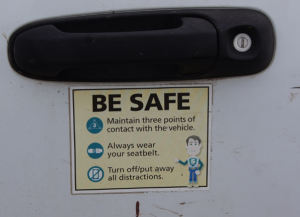 Quick, where is your cell phone? A pretty accurate guess for most readers is your cell phone is within arm’s reach, if not in your pocket or your hands. It probably has at least some portion of your attention right now, even as you’re reading this.
Quick, where is your cell phone? A pretty accurate guess for most readers is your cell phone is within arm’s reach, if not in your pocket or your hands. It probably has at least some portion of your attention right now, even as you’re reading this.
With the average person checking their phone 150 times a day, it’s clear that cell phones are ingrained in human behavior. The changes cell phones have made in daily lives has lead to a new, growing safety concern in the form of distracted walking.
Attention (the ability to concentrate on an activity for a prolonged period of time without getting distracted) is shrinking at an alarming rate, resulting in many unintentional injuries. From 2010 to 2011, there were more than 11,000 injuries due to distracted walking! Fifty-two percent of distracted walking injuries occur at home, with 54 percent to people 40 and younger, and nearly 80 percent of these injuries are due to falls. Instead of paying attention to where we are and what we’re doing, we’re trying to multitask and paying the price for it. Need more proof? Watch this video:
The human brain was not designed for divided attention (completing two tasks requiring the same concentration at the same time). When a cell phone user tries to walk at the same time, they’re missing out on significant cues, ultimately walking off course, stepping into traffic, or missing out on what’s going on around them. In a study conducted at Western Washington University, approximately 75 percent of cell phone users suffered from inattention blindness, failing to notice an out of place unicylcing clown in the square where they were walking. Just as inattention blindness contributes to vehicle collisions, it has also contributed to the rise in unintentional injuries from distracted walking.
To fix a safety issue, the typical steps are identifying the hazard and then:
- Eliminate the hazard when possible,
- Guard against hazards that cannot be eliminated
- Warn for hazards that can’t be eliminated or guarded against
- Change human behavior when there are no other options.
The hazard of distracted walking poses problems for the traditional eliminate, guard, and warn against options. Cell phones cannot be eliminated from every day life. Options to guard against the dangers of distracted walking are limited. Some restaurants are knocking out cell phone coverage to increase social interaction and minimize distractions but it is not a viable solution for public streets. Warnings can be sent via text/pop up messages but with distracted attention on cell phones, most will not be noticed or will be ignored.
This leaves us with the only, last option, to change human behavior. This is the least effective and slowest moving option for safety. Just look how long it took for regular seat belt usage to be the normal! Teaching ourselves to stop texting, tweeting, sharing, posting, and searching the internet while walking is going to a long, drawn out road. Abraham Lincoln couldn’t foresee the cell phone issue but he recognized human nature. “Human action can be modified to some extent but human nature cannot be changed,” Lincoln said.
Listen in as Kevin King discusses the issue of distracted walking and how it relates to our safety on People’s Law Talk.
It’s a newer, twenty-first century problem, but the statistics and facts on the distractions of cell phones, including the distracted walking hazard, are already rolling in. Check out these resources for more details on the issue:
- The National Safety Council
- Did You See the Unicylcing Clown: Inattentional Blindness While Walking and Talking on a Cell Phone from Western Washington State University
- The Mere Presence of a Cell Phone May Be Distracting from University of Southern Maine
- You’ll Never Learn from Slate
- Just How ‘Blind’ Are You When Talking on a Cell Phone? from NeuroNarrative
Want to hear more talks from Peter and Kevin King? Tune into WCIS 1010 AM Columbus, IN the first and third Friday of every month for People’s Law Talk.

 Spring, along with park visits and soccer games, will return soon. The season will bring the worry parents have about sports safety and playground equipment safety, but there’s an even more concerning safety issues you may not even be aware of. It’s the ground children play on: synthetic turf.
Spring, along with park visits and soccer games, will return soon. The season will bring the worry parents have about sports safety and playground equipment safety, but there’s an even more concerning safety issues you may not even be aware of. It’s the ground children play on: synthetic turf. That common backyard toy your kids continue to ask you for is more than just a toy; trampolines are a money pit and injury waiting to happen.
That common backyard toy your kids continue to ask you for is more than just a toy; trampolines are a money pit and injury waiting to happen.


